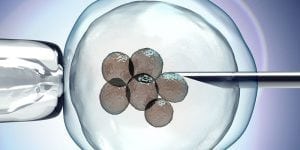For women struggling to get pregnant, there’s good news thanks to an advanced and simpler kind of IVF treatment called Mild IVF.
Most people today are familiar with IVF, or in vitro fertilization. It’s the process of artificially stimulating a woman’s ovary, removing an ovum (or egg) and fertilizing the egg in a liquid medium under laboratory settings.
If the egg is successfully fertilized, then it is cultured for two to six days and placed back into the uterus, hopefully creating a successful pregnancy.
While traditional IVF has revolutionized infertility treatment and has produced more than five million new babies, the process is highly expensive, can be painful and still has a 75 percent failure rate. Most couples also find IVF failure to be psychologically devastating.
Traditional IVF costs an average of $12,000, but then $3,000 to $5,000 more is needed for extra medicine. These costs are incurred each time the procedure is tried—and three out of four times it will fail.
Mild IVF is a New Approach
You might call this new method “IVF light.” It’s far less expensive, less stressful on the female body and the success rates may rival traditional IVF, although actual numbers are still tricky to calculate.
According to the Open Journal of Obstetrics and Gynecology, the new treatment method averages $8,789, plus medicine, or roughly half the cost of traditional IVF.
Less of everything is used, from drugs to procedures. The focus is on lower hormonal stimulation. The mild version is more natural, easier on the body and much less psychological stressful for a variety of reasons.
Shorter Treatment Time
For one thing, the treatment time is shorter. Conventional IVF involves four to five weeks of medication while mild IVF is just five to nine days. Mild works more with the body rather than against it by employing a gentler uterine stimulation method which may produce fewer eggs but tends to produce eggs of higher quality. Since less follicles are punctured, there are also less frequent symptoms after a follicular puncture.
Another advantage can be better implantation of eggs into the uterus. That’s because the drugs used to stimulate the uterus can have a negative impact on the chances of implantation and may even threaten the future health of the baby.
The new method does not involve the shutting down of the natural menstrual cycle. This reduces the emotional stress associated with unnaturally stopping and starting a woman’s natural cycle.
The treatment is not only short and less expensive, but safer. That’s because fewer drugs are needed, and that in turn means fewer side effects and rejection of harsh drugs by the female body.
For Whom Does it Work Best?

Some women also just don’t like the idea of taking a lot of drugs, making mild IVF an attractive option, as the ovaries are stimulated with rather low hormone levels.
Furthermore, women choosing mild IVF will have less risk of something called Ovarian Hyperstimulation Syndrome (OHSS) which can lead swollen and painful ovaries. Some women may develop severe OHSS. This can cause rapid weight gain, abdominal pain, vomiting and shortness of breath. More serious illness or even death can result from OHSS.
First Steps
Those opting for this pared down version of IVF start with getting a scan of their uterus using a 3D Doppler scanner. This will give doctors an excellent picture of the overall health and condition of the uterus, including the strength of the uterine lining. It can rule out the presence of obstructions such as cysts and polyps, while the blood flow to individual follicles is also examined.
Before or after the scan your doctors will gather a complete profile and history of your overall health. If the result of the uterine scan gives the “all clear” and you are determined to be overall healthy enough for this fertility treatment, the process can begin and will take about two weeks. If all goes well, mild IVF results in a healthy baby.
Mild ovarian stimulation is used more and more frequently in the context of fertility treamtent. In view of too low hormone levels, there is a risk that the attempt must be interrupted before the puncture of the follicles, but many women are more willing to start another trial because the procedure is much less stressful.




